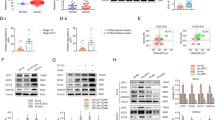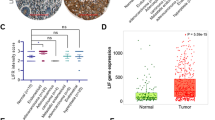Abstract
Aggressive cancers and embryonic stem (ES) cells share a common gene expression signature. Identifying the key factors/pathway(s) within this ES signature responsible for the aggressiveness of cancers can lead to a potential cure. In this study, we find that SALL4, a gene involved in the maintenance of ES cell self-renewal, is aberrantly expressed in 47.7% of primary human endometrial cancer samples. It is not expressed in normal or hyperplastic endometrial. More importantly, SALL4 expression is positively correlated with worse patient survival and aggressive features such as metastasis in endometrial carcinoma. Further functional studies have shown that loss of SALL4 inhibits endometrial cancer cell growth in vitro and tumorigenicity in vivo, as a result of inhibition of cell proliferation and increased apoptosis. In addition, downregulation of SALL4 significantly impedes the migration and invasion properties of endometrial cancer cells in vitro and their metastatic potential in vivo. Furthermore, manipulation of SALL4 expression can affect drug sensitivity of endometrial cancer cells to carboplatin. Moreover, we show that SALL4 specifically binds to the c-Myc promoter region in endometrial cancer cells. While downregulation of SALL4 leads to a decreased expression of c-Myc at both protein and mRNA levels, ectopic SALL4 overexpression causes increased c-Myc protein and mRNA expression, indicating that c-Myc is one of the SALL4 downstream targets in endometrial tumorigenesis. In summary, we are the first to demonstrate that SALL4 has functional role(s) in metastasis and drug resistance in aggressive endometrial cancer. As a consequence of its functional roles in cancer cell and absence in normal tissue, SALL4 is a potential novel therapeutic target for the high-risk endometrial cancer patient population.
This is a preview of subscription content, access via your institution
Access options
Subscribe to this journal
Receive 50 print issues and online access
$259.00 per year
only $5.18 per issue
Buy this article
- Purchase on Springer Link
- Instant access to full article PDF
Prices may be subject to local taxes which are calculated during checkout






Similar content being viewed by others
Accession codes
References
Amant F, Moerman P, Neven P, Timmerman D, Van Limbergen E, Vergote I . Endometrial cancer. Lancet 2005; 366: 491–505.
Saso S, Chatterjee J, Georgiou E, Ditri AM, Smith JR, Ghaem-Maghami S . Endometrial cancer. BMJ 2011; 343: d3954.
You JS, Kang JK, Seo DW, Park JH, Park JW, Lee JC et al. Depletion of embryonic stem cell signature by histone deacetylase inhibitor in nccit cells: involvement of nanog suppression. Cancer Res 2009; 69: 5716–5725.
Ben-Porath I, Thomson MW, Carey VJ, Ge R, Bell GW, Regev A et al. An embryonic stem cell-like gene expression signature in poorly differentiated aggressive human tumors. Nat Genet 2008; 40: 499–507.
Elling U, Klasen C, Eisenberger T, Anlag K, Treier M . Murine inner cell mass-derived lineages depend on Sall4 function. Proc Natl Acad Sci USA 2006; 103: 16319–16324.
Sakaki-Yumoto M, Kobayashi C, Sato A, Fujimura S, Matsumoto Y, Takasato M et al. The murine homolog of Sall4, a causative gene in Okihiro syndrome, is essential for embryonic stem cell proliferation, and cooperates with Sall1 in anorectal, heart, brain and kidney development. Development 2006; 133: 3005–3013.
Ma Y, Cui W, Yang J, Qu J, Di C, Amin HM et al. Sall4, a novel oncogene, is constitutively expressed in human acute myeloid leukemia (AML) and induces AML in transgenic mice. Blood 2006; 108: 2726–2735.
Cao D, Humphrey PA, Allan RW . Sall4 is a novel sensitive and specific marker for metastatic germ cell tumors, with particular utility in detection of metastatic yolk sac tumors. Cancer 2009; 115: 2640–2651.
Kobayashi D, Kuribayashi K, Tanaka M, Watanabe N . Overexpression of Sall4 in lung cancer and its importance in cell proliferation. Oncol Rep 2011; 26: 965–970.
Kobayashi D, Kuribayshi K, Tanaka M, Watanabe N . Sall4 is essential for cancer cell proliferation and is overexpressed at early clinical stages in breast cancer. Int J Oncol 2011; 38: 933–939.
Levan K, Partheen K, Osterberg L, Olsson B, Delle U, Eklind S et al. Identification of a gene expression signature for survival prediction in type i endometrial carcinoma. Gene Expr 2010; 14: 361–370.
Yang J, Chai L, Fowles TC, Alipio Z, Xu D, Fink LM et al. Genome-wide analysis reveals Sall4 to be a major regulator of pluripotency in murine-embryonic stem cells. Proc Natl Acad Sci USA 2008; 105: 19756–19761.
Yang J, Chai L, Gao C, Fowles TC, Alipio Z, Dang H et al. Sall4 is a key regulator of survival and apoptosis in human leukemic cells. Blood 2008; 112: 805–813.
Zhang J, Tam WL, Tong GQ, Wu Q, Chan HY, Soh BS et al. Sall4 modulates embryonic stem cell pluripotency and early embryonic development by the transcriptional regulation of Pou5f1. Nat Cell Biol 2006; 8: 1114–1123.
Wu Q, Chen X, Zhang J, Loh YH, Low TY, Zhang W et al. Sall4 interacts with nanog and co-occupies nanog genomic sites in embryonic stem cells. J Biol Chem 2006; 281: 24090–24094.
Mehlen P, Puisieux A . Metastasis: a question of life or death. Nat Rev 2006; 6: 449–458.
Elit L, Hirte H . Current status and future innovations of hormonal agents, chemotherapy and investigational agents in endometrial cancer. Curr Opin Obstet Gynecol 2002; 14: 67–73.
Liao DJ, Dickson RB . C-Myc in breast cancer. Endocr Relat Cancer 2000; 7: 143–164.
Little CD, Nau MM, Carney DN, Gazdar AF, Minna JD . Amplification and expression of the c-Myc oncogene in human lung cancer cell lines. Nature 1983; 306: 194–196.
Borst MP, Baker VV, Dixon D, Hatch KD, Shingleton HM, Miller DM . Oncogene alterations in endometrial carcinoma. Gynecol Oncol 1990; 38: 364–366.
Knapp DC, Mata JE, Reddy MT, Devi GR, Iversen PL . Resistance to chemotherapeutic drugs overcome by c-Myc inhibition in a Lewis lung carcinoma murine model. Anticancer Drugs 2003; 14: 39–47.
Van Waardenburg RC, Prins J, Meijer C, Uges DR, De Vries EG, Mulder NH . Effects of c-Myc oncogene modulation on drug resistance in human small cell lung carcinoma cell lines. Anticancer Res 1996; 16: 1963–1970.
Wolfer A, Wittner BS, Irimia D, Flavin RJ, Lupien M, Gunawardane RN et al. Myc regulation of a ‘poor-prognosis’ metastatic cancer cell state. Proc Natl Acad Sci USA 1996; 107: 3698–3703.
Hermeking H . The Myc oncogene as a cancer drug target. Curr Cancer Drug Targets 2003; 3: 163–175.
Yong KJ, Gao C, Lim JS, Yan B, Yang H, Dimitrov T et al. Oncofetal gene SALL4 in aggressive hepatocellular carcinoma. N Engl J Med 2013; 368: 2266–2276.
Renaud EJ, MacLaughlin DT, Oliva E, Rueda BR, Donahoe PK . Endometrial cancer is a receptor-mediated target for mullerian inhibiting substance. Proc Natl Acad Sci USA 2005; 102: 111–116.
Wong JY, Huggins GS, Debidda M, Munshi NC, De Vivo I . Dichloroacetate induces apoptosis in endometrial cancer cells. Gynecol Oncol 2008; 109: 394–402.
Du YC, Chou CK, Klimstra DS, Varmus H . Receptor for hyaluronan-mediated motility isoform B promotes liver metastasis in a mouse model of multistep tumorigenesis and a tail vein assay for metastasis. Proc Natl Acad Sci USA 2011; 108: 16753–16758.
Jeong HW, Cui W, Yang Y, Lu J, He J, Li A et al. Sall4, a stem cell factor, affects the side population by regulation of the Atp-binding cassette drug transport genes. PLoS One 2011; 6: e18372.
Yang J, Chai L, Liu F, Fink LM, Lin P, Silberstein LE et al. Bmi-1 is a target gene for sall4 in hematopoietic and leukemic cells. Proc Natl Acad Sci USA 2007; 104: 10494–10499.
Frank SR, Schroeder M, Fernandez P, Taubert S, Amati B . Binding of c-Myc to chromatin mediates mitogen-induced acetylation of histone H4 and gene activation. Genes Dev 2001; 15: 2069–2082.
Acknowledgements
This work was supported in part through NIH grants PO1DK080665, NIH RO1HL092437, and PO1HL095489 (to LC). We also thank Nicole Tenen and Joline Lim in assisting with the preparation of the manuscript and Xi Tian in helping with mouse work.
Author information
Authors and Affiliations
Corresponding author
Ethics declarations
Competing interests
The authors declare no conflict of interest.
Additional information
Supplementary Information accompanies this paper on the Oncogene website
Supplementary information
Rights and permissions
About this article
Cite this article
Li, A., Jiao, Y., Yong, K. et al. SALL4 is a new target in endometrial cancer. Oncogene 34, 63–72 (2015). https://doi.org/10.1038/onc.2013.529
Received:
Revised:
Accepted:
Published:
Issue Date:
DOI: https://doi.org/10.1038/onc.2013.529
Keywords
This article is cited by
-
SALL4 promotes angiogenesis in gastric cancer by regulating VEGF expression and targeting SALL4/VEGF pathway inhibits cancer progression
Cancer Cell International (2023)
-
Co-expression of cancer stem cell markers, SALL4/ALDH1A1, is associated with tumor aggressiveness and poor survival in patients with serous ovarian carcinoma
Journal of Ovarian Research (2022)
-
WAPL induces cervical intraepithelial neoplasia modulated with estrogen signaling without HPV E6/E7
Oncogene (2021)
-
VHL mutation-mediated SALL4 overexpression promotes tumorigenesis and vascularization of clear cell renal cell carcinoma via Akt/GSK-3β signaling
Journal of Experimental & Clinical Cancer Research (2020)
-
SALL4 promotes gastric cancer progression via hexokinase II mediated glycolysis
Cancer Cell International (2020)



